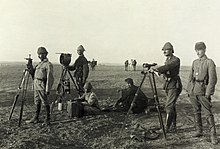Signal lamp

Signal lamp training during World War II.
A signal lamp (sometimes called an Aldis lamp, after Arthur Cyril Webb Aldis, who invented a widely used design, or a Morse lamp[1]) is a visual signaling device for optical communication, typically using Morse code. Modern signal lamps are focused lamps which can produce a pulse of light. In large versions, this pulse is achieved by opening and closing shutters mounted in front of the lamp, either via a manually operated pressure switch, or, in later versions, automatically. With hand held lamps, a concave mirror is tilted by a trigger to focus the light into pulses. The lamps were usually equipped with some form of optical sight, and were most commonly used on naval vessels and in airport control towers (using color signals for stop or clearance). In manual signaling, a signalman would aim the light at the recipient ship and turn a lever, opening and closing the shutter over the lamp, to emit flashes of light to spell out text messages in Morse code. QOn the recipient ship, a signalman would observe the blinking light, often with binoculars, and translating the code into text.
Contents
1 Marine usage
2 Early history
3 Modern use
4 Air traffic control usage
5 See also
6 References
7 External links
Marine usage

US Navy sailor sending Morse code using a signal lamp.
Signal lamps were pioneered by the Royal Navy in the late 19th century and continue to be used to the present day on naval vessels. They provide handy, relatively secure communications, which are especially useful during periods of radio silence, such as for convoys operating during the Battle of the Atlantic.
There are several types. Some signal lamps are mounted on the mastheads of ships, some small hand-held versions are also used (e.g., the 'Aldis lamp'); other more powerful versions are mounted on pedestals. These larger ones use a carbon arc lamp as their light source, with a diameter of 20 inches (50 cm). These can be used to signal to the horizon, even in conditions of bright sunlight. Although it was originally thought that it was only possible to communicate by line-of-sight, in practice it is possible to illuminate cloud bases both during the night and day, which allow for communication beyond the horizon.
The maximum transmission rate possible via flashing lights is no more than 14 wpm. They have a secondary function as simple spotlights.
Early history

Begbie signalling oil lamp, 1918
The idea of flashing dots and dashes from a lantern was first put into practice by Captain, later Vice Admiral, Philip Colomb, of the British Royal Navy, in 1867. His original code, which the Navy used for seven years, was not identical with Morse's, but Morse code was eventually adopted with the addition of several special signals.
Another signalling lamp was the Begbie lamp, a kerosene lamp with a lens to focus the light over a long distance.[2]
Flashing lights were the second generation of signalling in the Royal Navy, after the flag signals most famously used to spread Nelson's rallying-cry before the Battle of Trafalgar.

WW I German Blinkgerät
During the trench warfare of World War I when wire communications were often cut, German signals used three types of optical Morse transmitters, called Blinkgerät, the intermediate type for distances of up to 4 km (2.5 miles) at daylight and of up to 8 km (5 miles) at night, using red filters for undetected communications.[citation needed]

A Blinkgerät can be seen second from the left in this picture of an Ottoman heliograph crew.
Modern use
The Commonwealth navies and NATO forces use signal lamps when radio communications need to be silent or electronic "spoofing" is likely. Also, given the prevalence of night vision equipment in today's armed forces, signaling at night is usually done with lights that operate in the infrared (IR) spectrum, making them less likely to be detected. All modern forces have followed suit due to technological advances in digital communications.[3]
Air traffic control usage
In air traffic control towers, signal lamps are still used today, as a backup device in case of a complete failure of an aircraft's radio. Light signals can be green, red, or white, and steady or flashing. Messages are limited to a handful of basic instructions (e.g., "land", "stop", etc.); they are not intended to be used for transmitting messages in Morse code. Aircraft can acknowledge signals by rocking their wings or flashing their landing lights.[4]
See also
- Colt Acetylene Flash Lantern
- Flag semaphore
- Heliograph
References
^ Lord, Walter. The Night Lives On..mw-parser-output cite.citation{font-style:inherit}.mw-parser-output .citation q{quotes:"""""""'""'"}.mw-parser-output .citation .cs1-lock-free a{background:url("//upload.wikimedia.org/wikipedia/commons/thumb/6/65/Lock-green.svg/9px-Lock-green.svg.png")no-repeat;background-position:right .1em center}.mw-parser-output .citation .cs1-lock-limited a,.mw-parser-output .citation .cs1-lock-registration a{background:url("//upload.wikimedia.org/wikipedia/commons/thumb/d/d6/Lock-gray-alt-2.svg/9px-Lock-gray-alt-2.svg.png")no-repeat;background-position:right .1em center}.mw-parser-output .citation .cs1-lock-subscription a{background:url("//upload.wikimedia.org/wikipedia/commons/thumb/a/aa/Lock-red-alt-2.svg/9px-Lock-red-alt-2.svg.png")no-repeat;background-position:right .1em center}.mw-parser-output .cs1-subscription,.mw-parser-output .cs1-registration{color:#555}.mw-parser-output .cs1-subscription span,.mw-parser-output .cs1-registration span{border-bottom:1px dotted;cursor:help}.mw-parser-output .cs1-ws-icon a{background:url("//upload.wikimedia.org/wikipedia/commons/thumb/4/4c/Wikisource-logo.svg/12px-Wikisource-logo.svg.png")no-repeat;background-position:right .1em center}.mw-parser-output code.cs1-code{color:inherit;background:inherit;border:inherit;padding:inherit}.mw-parser-output .cs1-hidden-error{display:none;font-size:100%}.mw-parser-output .cs1-visible-error{font-size:100%}.mw-parser-output .cs1-maint{display:none;color:#33aa33;margin-left:0.3em}.mw-parser-output .cs1-subscription,.mw-parser-output .cs1-registration,.mw-parser-output .cs1-format{font-size:95%}.mw-parser-output .cs1-kern-left,.mw-parser-output .cs1-kern-wl-left{padding-left:0.2em}.mw-parser-output .cs1-kern-right,.mw-parser-output .cs1-kern-wl-right{padding-right:0.2em}
^ Neal McEwen, K5RW. "Victorian Era Visual Signalling Instruments -Black Watch, 42nd Royal Highland Regiment Signalling Unit, c. 1898". Telegraph-office.com. Retrieved 2012-06-13.
^ "Visual Signalling in the RCN - Light Signalling". www.jproc.ca. Retrieved 2016-08-05.
^ FAA Aeronautical Information Manual, section 4-3-13. Traffic Control Light Signals Archived 2012-11-04 at the Wayback Machine
External links
| Wikimedia Commons has media related to Signalling lamps. |
- An Aldis lamp in operation